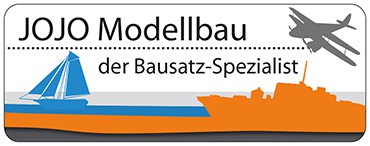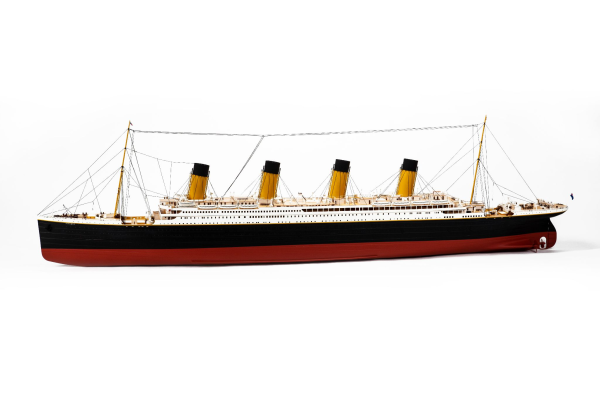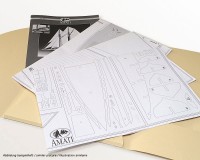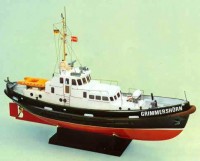Prices incl. VAT plus shipping costs
delivery time 2-7 working days Europe longer
- Order number: BB0510
- Hersteller: Billing Boats
- Zustand: Neuer Artikel
RMS Titanic - RC model with gigantic dimensions.
At almost 1.9 metres in length, this is the largest kit we can offer you as a remote-controlled model ship.
The RMS Titanic began her maiden voyage from Southarnpton to New York on Wednesday 10 April 1912 under her captain Edward John Smith. Rumour has it that the maiden voyage of the Titanic was to be his last voyage as captain before his retirement. Other sources claim that this was only planned for the maiden voyage of the Britannic. The ship set sail from its berth in Southampton harbour shortly after 12 noon. Due to a previous coal strike, there were more ships in the harbour than usual. As the RMS Titanic passed the steamers New York and Oceanic, the New York's mooring lines broke due to the suction from the Titanic. As a result, the New York slowly drifted towards the Titanic. A collision was narrowly avoided, but the incident delayed the Titanic's departure by an hour. In the early evening, the Titanic anchored off Cherbourg in France, where further cargo and 274 passengers were brought on board by tender. 22 passengers who had only wanted to cross the Channel disembarked.
At around midday on 11 April, the RMS Titanic anchored off Queenstown in Ireland, where mainly emigrants boarded in third class. Only seven passengers travelling to Ireland disembarked. At around 13:30, the voyage began on the traditional North Atlantic route for passenger ships towards New York, where arrival was scheduled for Wednesday 17 April. After a three-day stay there, the return journey was to take place. The Titanic's voyage was abruptly disrupted on Sunday 14 April at around 23:40 ship's time. The lookout Frederick Fleet spotted an iceberg directly ahead and rang the alarm bell three times. He passed this warning directly to the bridge by telephone, where it was picked up by 6th Officer James P. Moody. While Fleet was on the phone, his colleague Reginald Lee noticed that the Titanic was beginning to turn. The officer on watch on the bridge had therefore already initiated a port rounding manoeuvre, suggesting that he had already spotted the iceberg.
However, the distance to the iceberg was already too small. At full cruising speed, the ship's forward starboard side collided with the iceberg, which is estimated to weigh 300,000 tonnes. The iceberg probably originated from Jakobshavn lsbras, a glacier in western Greenland. The collision damaged the bow, from the forepeak to just behind the point of the ship that corresponded to the centre of rotation when turning. At full speed, this centre of rotation was approximately on the border between the fifth and sixth watertight compartments. Several leaks affected all six forward watertight compartments, resulting in the foredeck sinking due to water ingress. While the forward five compartments filled up quickly, the flooding in the sixth compartment was slowed down by the pumps. In the first hour, between 22,000 tonnes and 25,000 tonnes of water flowed into the ship. The front five compartments were almost completely flooded, after which the RMS Titanic almost reached equilibrium for a short time. The inclination of the ship at this point was around 5° towards the bow, which most people probably did not yet perceive as threatening. In the following hour, a maximum of another 6,000 tonnes of water entered the ship, but the inclination did not change significantly. However, secondary flooding now increasingly began, as more and more non-watertight openings in the ship, such as open portholes, ventilation shafts and hatches in the sinking bow, came below the waterline. This caused the sinking process to accelerate rapidly.
After the sinking, the rescued people had to wait in the boats for around two hours before they could be picked up by the RMS Carpathia. The night of the sinking was very cold, the water temperature was below 0 degrees, slightly above the freezing point of seawater. Many people did not die on the ship during the sinking, but only afterwards in the water from hypothermia and were floating lifeless in the water when the RMS Carpathia of the British Cunard Une arrived at 4.10 am. Although there were still several hundred free seats in the Titanic boats, the occupants rowed away from those calling for help for fear that their boat might capsize if too many of those floating in the water tried to climb aboard. Only lifeboat number 4 turned back. However, there were only five survivors, two of whom died in the boat. At around 3 o'clock, some 40 minutes after the Titanic sank, the last cries for help from the water died down. Only then did boat number 14, under the command of 5th officer Harold Lowe, who had had the passengers transferred to other lifeboats, return to those floating in the water. Three more people were rescued who had initially saved themselves on flotsam. According to the British investigation report, only a total of 711 people survived.
RMS Titanic - RC model kit:
The model is built using the classic keel and frame construction method. The installation of the engines and the outer ship's shafts is already included. The engines are not included in the kit. The central propeller is only designed as a dummy and remains fixed. The hull is planked with a layer of wooden strips and sanded. Only then are the laser-cut strips with the countless portholes attached.
In addition to the countless and wonderfully detailed laser-etched superstructure parts, the large etched plates with window frames and decorations are a special feast for the builder's eyes.
Kit contents:
Laser-etched wooden panels
Various mouldings for the panelling etc.
Four large plates with photo-etched parts
Brass chimneys
Complete set of brass fittings. Only the lifeboats and anchors are made of plastic.
Brass propellers and stern tube and shaft
Rigging twine
Flag set
2 plan sheets with top view, side view and stern view on a scale of 1:1
Building instructions in A3 format with parts list, reduced-size illustrations of the loaded wooden panels and photo-etched parts, notes on the colour scheme, 62 drawing sheets with information on the building sequence, many detailed drawings and notes on installing the remote control.
Technical data:
Scale: 1:144
Overall length: 1880 mm
Overall width: 200 mm
Height: 500 mm
| Material Rumpf: | Holz |
| Breite: | 200mm |
| Difficulty: | profi |
| Höhe: | 500mm |
| Länge: | 1880mm |
| Maßstab: | M 1:144 |
BILLING BOATS Vestergaard Group
Jegindøvej 21
8800 Viborg
Dänemark
www.billingboats.com
Vestergaard Group
Jegindovej 21
8800 Viborg
Dänemark
salg@veste.dk
- Kein Spielzeug
- Nicht geeignet für Kinder unter 14 Jahre
- Enthält verschluckbare Kleinteile
 Rumpf rot 22 ml Billing Boats Acryl Farben
Rumpf rot 22 ml Billing Boats Acryl Farben  Pale grau 22 ml Billing Boats Acryl Farben
Pale grau 22 ml Billing Boats Acryl Farben  Trainer gelb 22 ml Billing Boats Acryl Farben
Trainer gelb 22 ml Billing Boats Acryl Farben  Matt weiß 22 ml Billing Boats Acryl Farben
Matt weiß 22 ml Billing Boats Acryl Farben  Satin braun 22 ml Billing Boats Acryl Farben
Satin braun 22 ml Billing Boats Acryl Farben  Matt Schwarz 22 ml Billing Boats Acryl Farben
Matt Schwarz 22 ml Billing Boats Acryl Farben  Beize Mahagoni 22 ml Billing Boats Acryl Farben
Beize Mahagoni 22 ml Billing Boats Acryl Farben 



































































